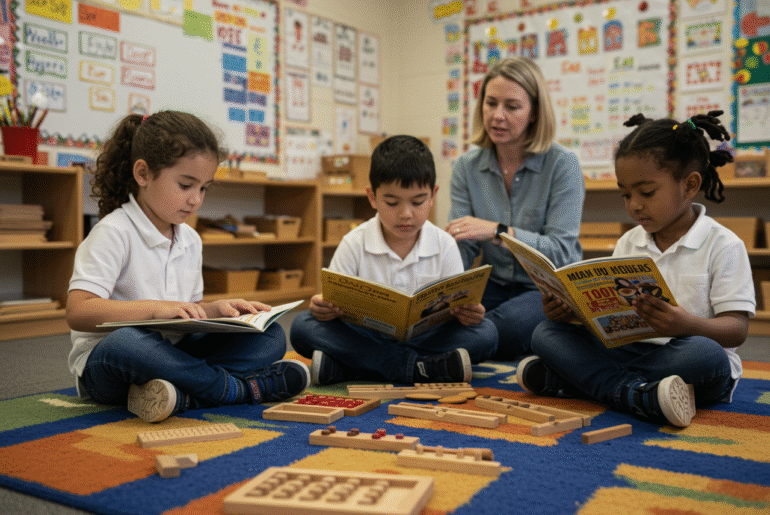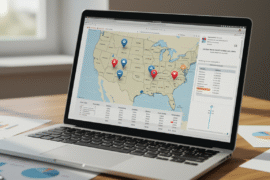This article may contain references to products or services from one or more of our advertisers or partners. We may receive compensation when you click on links to those products or services. Nonetheless, our opinions are our own.
The information presented in this article is accurate to the best of our knowledge at the time of publication. However, information is subject to change, and no guarantees are made about the continued accuracy or completeness of this content after its publication date.
What the U.S. Department of Education Does and Why It Matters
Lately, people have been arguing a lot about the U.S. Department of Education. You’ve probably seen the headlines; some love it, others want big changes. But before getting lost in all the drama, let’s go back to basics: What is this department, and what does it even do?
Understanding that can help you see why everyone’s so fired up and how it all affects students, teachers, and schools.
What the Department Really Does
The Department of Education makes rules and plans for schools all across the country. Its main job? Try to make sure every kid, no matter where they live, gets a decent shot at learning.
Here’s how it helps:
- Sets Standards: It decides what students should know at each grade level.
- Gives Out Money: It sends money to help schools, especially in places that are struggling.
- Launches Programs: It starts things like STEM lessons or special help for students with disabilities.
Like recently, they’ve been putting money into better internet and digital tools to help schools catch up.
| State | Money Given (Millions) | Focus Area |
|---|---|---|
| California | $1,250 | STEM Education |
| Texas | $800 | Training Teachers |
| New York | $900 | Special Education |
Voted "Best Overall Budgeting App" by Forbes and WSJ
Monarch Money helps you budget, track spending, set goals, and plan your financial future—all in one app.
Get 50% OFF your first year with code MONARCHVIP
How Federal Rules Affect Local Schools
Rules made in Washington can shape your neighborhood school in big ways. Some rules help others but just create more work for teachers.
- Money: Federal cash can help, but schools sometimes have to fill out tons of forms to get it.
- Lessons: Some rules tell schools what to teach, leaving little room for creativity.
- Testing: National tests can take over, pushing aside more fun or hands-on learning.
| Area | What Happens |
|---|---|
| Funding | Goes up or down |
| Curriculum | Becomes more uniform |
| Testing | Can stifle creativity |
The Problems It Faces and How They Affect Students
The Department’s got a lot of problems on its plate:
- Not Enough Money in Some Places: Some schools barely get by. That means old books, crowded classes, and broken equipment.
- Too Few Teachers: Lots of teachers are quitting because the pay’s low and the work is stressful. That means bigger classes and less attention for each kid.
| Problem | What It Means for Kids |
|---|---|
| Less Funding | Fewer tools, less support |
| Teacher Shortages | Less one-on-one help, bigger classes |
Why School Funding Isn’t Fair
A big chunk of school money comes from local property taxes. Rich areas get more cash; poorer areas get less. That means some kids get way more than others, just based on their ZIP code.
| Area Type | Per Student Funding |
|---|---|
| Wealthy County | $15,000 |
| Middle-Class | $10,000 |
| Low-Income Area | $7,500 |
What You Can Do to Help Schools
You don’t need to be a politician to make a difference:
- Go to school board meetings: This is where decisions get made.
- Talk to teachers: They know what’s working and what’s not.
- Join a group: Team up with others who want better schools.
- Other options:
- Start a petition
- Host a community meeting
- Work with local nonprofits
- Post online to raise awareness
Ways to Stay Informed
Want to stay updated and make smarter decisions? Try this:
- Follow the news
- Go to local school meetings or read their notes online
- Join online education groups
- Chat with local teachers
- Listen to podcasts about schools and learning
| Issue | Status | What You Can Do |
|---|---|---|
| School Funding | Pending | Attend a budget meeting |
| Testing Reform | In Debate | Read and share new ideas |
| Teacher Pay Raises | Approved | Watch how it’s rolled out |
Summary of the Department of Education’s Role
The U.S. Department of Education may seem distant, but it shapes the everyday lives of students, teachers, and communities. From funding and teacher support to digital tools and testing requirements, its decisions reach every corner of the country. While challenges like unequal funding and teacher shortages persist, being informed helps people push for change. You don’t need to hold office to make a difference; local involvement matters. By showing up, speaking out, and supporting policies that help students, everyone can play a role in improving education for the next generation.
Frequently Asked Questions
What does the Education Department do?
It helps students learn and tries to make the school fair for everyone. It provides funding, sets national education goals, and monitors civil rights compliance in education.
How does it affect public schools?
It sets rules, gives money, and checks if schools follow civil rights laws. Its decisions can impact classroom content, teaching strategies, and available resources.
What programs does it run?
It operates programs such as Title I for underfunded schools and Pell Grants for college students, among others, that support educational access and innovation.
Why do people criticize it?
Some people say the Department mishandles student loans, enforces too many regulations, or fails to address long-standing issues like unequal funding.
What about colleges?
It manages federal financial aid and ensures colleges meet specific standards, helping students access quality higher education.
What does it do during emergencies?
It gives schools advice and extra help, such as funding or resources, especially during crises like the COVID-19 pandemic.
How can I get involved?
You can visit their website, attend public hearings, or speak at local school board meetings to voice your concerns or ideas.

Reviewed and edited by Albert Fang.
See a typo or want to suggest an edit/revision to the content? Use the contact us form to provide feedback.
At FangWallet, we value editorial integrity and open collaboration in curating quality content for readers to enjoy. Much appreciated for the assist.
Did you like our article and find it insightful? We encourage sharing the article link with family and friends to benefit as well - better yet, sharing on social media. Thank you for the support! 🍉
Article Title: What the U.S. Department of Education Does and Why It Matters in 2025
https://fangwallet.com/2025/08/06/what-the-u-s-department-of-education-does-and-why-it-matters-in-2025/The FangWallet Promise
FangWallet is an editorially independent resource - founded on breaking down challenging financial concepts for anyone to understand since 2014. While we adhere to editorial integrity, note that this post may contain references to products from our partners.
The FangWallet promise is always to have your best interest in mind and be transparent and honest about the financial picture.
Become an Insider

Subscribe to get a free daily budget planner printable to help get your money on track!
Make passive money the right way. No spam.
Editorial Disclaimer: The editorial content on this page is not provided by any of the companies mentioned. The opinions expressed here are the author's alone.
The content of this website is for informational purposes only and does not represent investment advice, or an offer or solicitation to buy or sell any security, investment, or product. Investors are encouraged to do their own due diligence, and, if necessary, consult professional advising before making any investment decisions. Investing involves a high degree of risk, and financial losses may occur including the potential loss of principal.
Source Citation References:
+ Inspo
There are no additional citations or references to note for this article at this time.












































